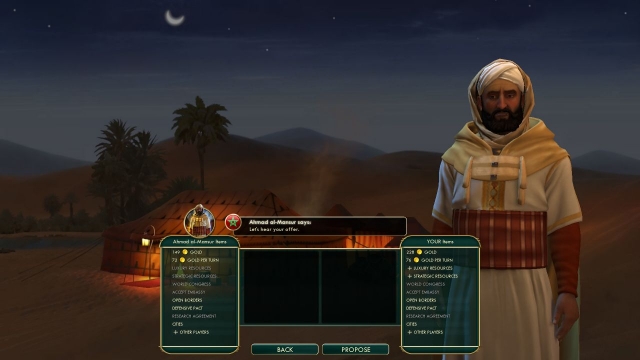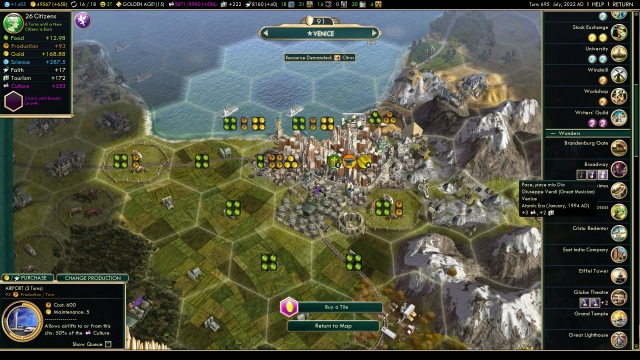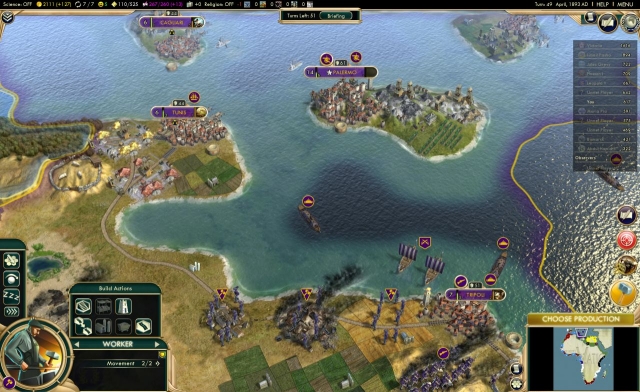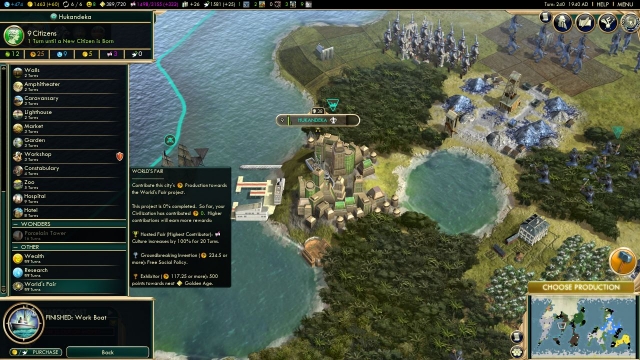Civilization V: Brave New World
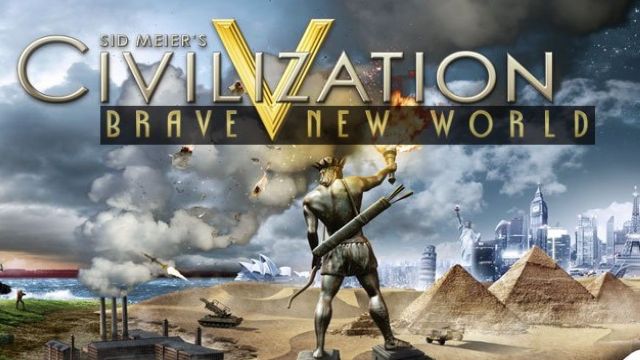
The end game of Civilization games (all of them) has always been their biggest weakness. From the ancient and classical era, when everyone is still exploring and expanding, to the medieval and renaissance era, when alliances, religions and border wars wax and wane, the first half of any Civilization V game is always addictive. By like clockwork, right around the middle of the industrial era, the fun seems to tighten, only leaking out in dribs and drabs. Those border wars have mostly settled down, religions are pretty well locked into place, and it’s usually just a smooth coast to your chosen victory condition; that means lots and lots of clicking “end turn”. Would you believe me, then, if I said with a straight face that now, because of the Brave New World expansion, I look forward to the end game, that everything before the industrial era seems like a prelude to the final climax? It seems farfetched, I know.
Like all Civ expansions, Brave New World adds the trifecta of new civilizations, gameplay mechanics and scenarios. I’ll start with the scenarios because much as I usually skip right by them, it seems the developers at Firaxis felt much the same way this time around, only offering two relatively fast-paced entries. There’s a civil war scenario that lets you battle across northern Virginia and southern Maryland; it’s exactly what you would expect: some historically located cities, lots of units, a few technologies to discover and lots and lots of battles. Much like the Fall of Rome scenario from Gods and Kings, most of your turns in this one are spent smashing units into each other. Not really my cup of tea.
The second scenario, Scramble for Africa, is a far more interesting 100-turn adventure. Picking a civ from amongst a loose collection of factions, you are tasked with either plundering Africa or protecting it. The European nations must explore the landscape and unearth ruins, the northern Africans strive to become economic powerhouses and southern Africans hope to maintain autonomy by boosting their culture. I actually really dig the fact that depending on who you play as, you are building towards different endgames. It’s like they took the standard game and focused it into a tighter, more specific experience. Of the two, this one is clearly the one that would bear repeated play-throughs.
But let’s be honest, these aren’t why most people will decide whether or not to buy Brave New World. What are those new civs like? Well, let’s run through the highlights. My favorite new civilizations thus far have to be the Shoshone and Portuguese. Starting with enormous swaths of land and being able to choose your ruin bonuses makes the first fifty turns as the Shoshone insanely fun. And while Portugal’s ability isn’t some game-bending craziness, being able to steal a city-state’s luxury resources by placing a special “Feitoria” improvement in their borders is pretty neat. Plus, who is going to argue with all the gold from those naval trade routes (more on that later). Even France and Arabia got a big overhaul, letting them take full advantage of the new systems.
Of course, a few of the new civilizations aren’t quite as exciting. Poland’s extra social policy per era and horse focus seems like a bit of a rehash of other civs. And then there’s weirdly unique Venice. Masters of trade but only able to found and control one city (all others must remain puppets), these guys looked extremely fun on paper. I won’t say they aren’t, but damned if I suck at using them. Being able to purchase city-states outright with their special “merchant of Venice” great person sounds incredibly powerful, but it’s quite easy to find yourself having to defend far-flung outposts halfway around the world with little or no support. I’m going to keep at them, and maybe I’ll find their sweet spot strategy. Regardless of a few lackluster areas, the new civilizations are, on the whole, a more interesting collection than Gods and Kings offered.
The real meat and potatoes of Brave New World, as you might have guessed, are the addition of a slew of new game mechanics. Proceeding in chronological gaming order, the first thing you’ll notice is that you have to earn your gold-per-turn through trade routes. Starting out as one simple camel convoy wandering back and forth between your capital and the nearest city-state, eventually you’ll grow a trading empire over both land and sea, across the globe, earning not only gold, but spreading science, religion and even tourism. While the profits have gone up, so has the danger, as trade routes can be raided by enemies at any time, which if it happens at a critical point, can change the course of a war. This makes turtling up harder as the only way to stay afloat, financially, is to be proactive in protecting your precious income.
Once someone discovers the printing press and knows all of world’s civilizations, the World Congress convenes. In the beginning, proposals such as “world religion” and “trade embargo” take a long time to vote on, giving you time to turn your spies into diplomats and send them to rival capitals so that you can wheel and deal with other leaders to vote the way you want them to. Most of the time, proposals are just harmless extras like initiating a World’s Fair, but sometimes, events like the banning of your favorite luxury sneaks through and can be a real detriment to your happiness. Like most aspects of Civ V, if you work the World Congress (and later, the UN) aggressively it can really pay dividends the entire latter half of the game. The diplomatic victory still entails being voted “world leader” with a majority of votes (including city-states), but all along the way, diplomacy feels a great deal more dynamic now.
The other victory condition to get a major overhaul is the culture game. What used to be a pretty boring process of founding three or four cities and then hitting “enter” most of the game has now expanded to include tourism. Culture still functions in the same basic capacity (granting you access to social policies), but once you start producing artists, writers and musicians and use them to craft their appropriate great works (Leonardo di Vinci will paint you the Mona Lisa, for example), you begin the tourism minigame. Placing those works in your museums, amphitheaters and even great wonders generates your “offensive” tourism to other civs’ “defensive” culture. I know, it sounds a little complicated but once you get rolling, it’s pretty straightforward and you can even arrange your paintings by culture and era to get “theme bonuses” from wonders. Eventually, if your tourism can overcome everyone’s culture, you win, simple as that. As such, the culture victory went from being one of the hardest, longest victories in the game to being one of the quicker ones, if you focus on it.
Helping you with your tourism is the new archaeology mechanic. Right from the start, your game begins recording where battles and other significant events took place and seeding hidden antiquity sites around the map. Once you discover the eponymous technology, you can send out archeologists to those sites and either bring home a historical artifact (beads and arrowheads) for tourism purposes, Indiana Jones-style, or you can set up a cultural monument for your cities to work. It’s a small touch, in the grand scheme, but still something helpful and fun to choose to interact with as you play.
Finally, once you get into the industrial age, the cold war of Ideologies begins. Freedom, Autocracy and Order have been moved out of the standard social policy lineup and now inhabit a new area where, much like religion, you can pick and choose your bonuses based on how you’re playing. What’s more, depending on how much tourism you’re generating, your ideology can become so dominant that other civs’ populations will become unhappy if they picked a different path. And this leads directly into my favorite aspect of the expansion: everything is tied together.
It’s not enough to throw a whole bunch of disparate mechanisms into a game and hope for the best. Understanding this, Firaxis worked overtime to make sure that every new feature they added interacted with every other feature, including religion and espionage from Gods and Kings. Trade routes spread religion and tourism, tourism puts added pressure on ideologies, ideologies form voting blocks in the world congress, the world congress affects almost everything in the game…the cycle goes on and on. While I expect a patch or two might address the balance of that interplay, the fact that it’s already so integrated and solid at launch makes the whole experience that much more rewarding.
By now, my opinion of Brave New World should be crystal clear. If you enjoy Civ V and Gods and Kings, this latest expansion is a must-buy, no-brainer. And while heaping massive amounts of glowing praise on a game might make for an unexciting review, I can’t help but to keep heaping. After all, Civilization V is now the most consistently fun game, from start to finish, in the series’ history. Well done, Firaxis.
Reviewed By: Brian Mardiney
Publisher: 2K Games
Rating: 92%
——————————————————————————–
This review is based on a digital copy of Civilization V: Brave New World for the PC provided by 2K Games.
 Game Over Online
Game Over Online